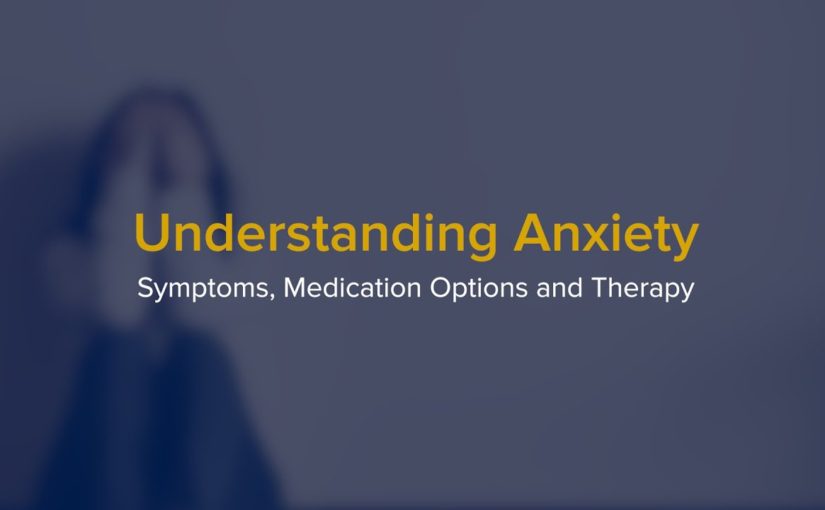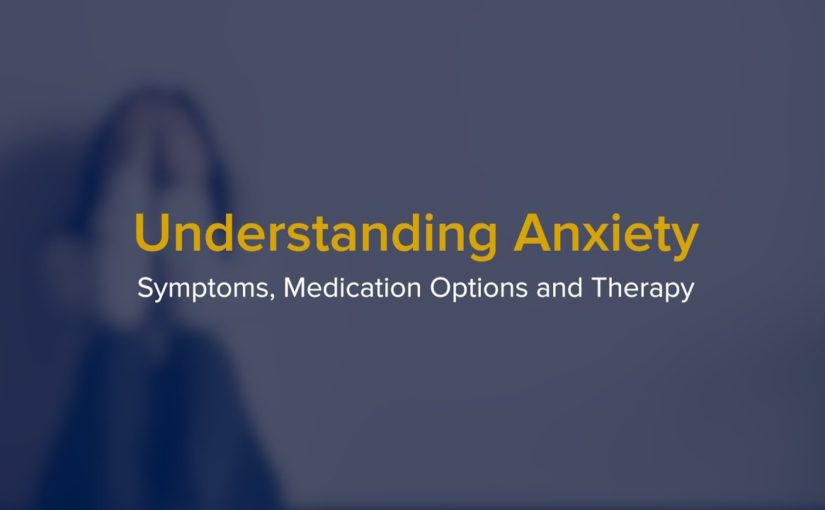Fear is
something that everybody experiences. We all have fear,
and fear is a normal response to a threat. The difference with anxiety
is that anxiety is more diffuse. It’s not specific to a threat. It’s more global and it’s more vague and general. A fear of elevators
could be rational if you know that the elevator
reached the maximum capacity or you know for sure
that it’s been failing or is shaking strangely, that’s rational, and avoiding that is normal. But anxiety would be for someone
to be afraid of elevators, even though it’s a perfectly functioning
elevator you know has been recently installed and checked and
technically is flawless, and you still have anxiety about that.Anxiety disorders are a large family
with several individual disorders, but it’s important to know
that sometimes they happen together or you may have one
and a little bit of another one. But the most common are panic
disorder, social anxiety disorder, we have also generalized anxiety
disorder, separation anxiety disorder, and the last one is selective mutism. It’s a rare disorder
that is mostly seen in children. In psychiatry,
probably the most successful group of illnesses or disorders
that we can treat successfully are anxiety disorders.
The treatment of choice is therapy. Multiple therapies are validated by research that can be effective. In addition to that,
we can use medications that are just as needed,
for example, panic attacks.Many people use a type of medication
called benzodiazepine. There’s a family of anti-anxiety medications. They can work for someone
who has only sporadic attacks, but not for someone who has chronic,
what is called generalized anxiety disorder, because it’s easy
to become dependent on those medications. The other mainstay type of treatment
in terms of medications is antidepressants, specifically the so-called serotonergic
antidepressants. Some of them, for example,
are sertraline or paroxetine and these medications
increase the transmission of serotonin in the brain and can alleviate
some of the symptoms of anxiety. When we are
thinking of treatment for anxiety disorders without medication,
we have therapy, but also we have self-help. So we can do a lot with self-help. Probably the most effective
are all kinds of activities that tend to reduce the activation of the stress response system in the body. So the stress response system releases
several chemicals, like cortisol and adrenaline,
but also changes the heart rate, breathing, and so forth. And so there are many activities,
including meditation, yoga, tai chi, and sports in general,
aerobic exercise, that can down-regulate the activation of the stress
response system.In addition to self-help, another type of non-medication,
non-pharmacological treatment for anxiety disorders
is therapy. Counseling. And several types are specific for anxiety and they’re being developed through
research and they are highly effective. One of the most common and most well-known is cognitive behavioral therapy,
which is a systematic training of the patient to identify certain thoughts and beliefs
that can be challenged, and the challenging
of switching reframing, and changing those thoughts can alleviate anxiety. The main coping skill for anxiety
is avoidance. Unfortunately, avoidance
is the worst thing that we can do because it will perpetrate
and make it chronic.The more we avoid something,
the more powerful that fear becomes, or that anxiety. Therefore,
one of the treatments for anxiety is to try not to avoid
the triggers, is to expose ourselves as much as we can tolerate that. For example,
if public speaking is a source of anxiety, some of us can get trained
and go to Toastmasters,
and go to a setting where we feel safer and slowly
and progressively expose ourselves. Because the brain learns not to react. With more practice, we lose that fear. If you believe
that you have an anxiety disorder, I would say the first thing to do
could be a screening for that. That could be done by your primary care
physician or yourself. One of the most common tools to screen for anxiety disorder
is called General Anxiety Disorder-7.GAD-7. And that’s widely available
in the public domain on the Internet. And if you have a suspicion
of an anxiety disorder, I would go to your primary care doctor. Alternatively, you can go to a therapist
because this, can be very effective and the therapist would be prepared
to tell you, “I think you need medication in addition to therapy.”.
ᵃⁿⁱᵐᵃᵗⁱᵒⁿ ˢᵗᵘᵈⁱᵒ ᴏɴᴇ-ᴛɪᴍᴇ ꜱᴘᴇᴄɪᴀʟ ᴜᴘɢʀᴀᴅᴇ ᴅᴇᴀʟ – ᴍᴀʏ ᴇxᴘɪʀᴇ ᴏɴᴄᴇ ʏᴏᴜ ʟᴇᴀᴠᴇ ᴛʜɪꜱ ᴘᴀɢᴇ. ꜱᴋɪᴘ ᴛʜɪꜱ ᴅᴇᴀʟ ᴀᴛ ʏᴏᴜʀ ᴏᴡɴ ʀɪꜱᴋ ᴀꜱ ᴛʜᴇ ᴘʀɪᴄᴇ ᴍᴀʏ ᴅᴏᴜʙʟᴇ ᴡɪᴛʜᴏᴜᴛ ɴᴏᴛɪᴄᴇ!
Animation Studio is a must-have for anyone serious about selling or promoting anything online with video! Damon Nelson. Wow, Paul & Todd, this is a competition killer. “
Animation Studio The
Animation Creator That You Have Been Waiting For Has Finally Arrived… …..”
 100 Hot BooksComputers LaptopsExplaindio Agency Edition FREE Training How to Create Explainer Videos & SELL or RENT them! Join this FREE webinar | Work Less & Earn More With Explaindio AGENCY EDITION
100 Hot BooksComputers LaptopsExplaindio Agency Edition FREE Training How to Create Explainer Videos & SELL or RENT them! Join this FREE webinar | Work Less & Earn More With Explaindio AGENCY EDITION
![[LIVE] Dog Music🎵Relaxation Music to Calm Your Dog🐶🎵Separation Anxiety Relief Music💖Dog Sleep🔴1-1](https://effectsofanxiety.net/wp-content/uploads/2024/07/maxresdefault-2024-07-09T101807.315-825x510.jpg)

![[LIVE] Dog Music🎵 Calming Music for Dogs🐶🎵 Soothing Sleep Music💖Anti Separation anxiety Relief 🔴 2-1](https://effectsofanxiety.net/wp-content/uploads/2024/06/Calming-Music-for-Dogs-5-825x510.jpg)
![[LIVE] Dog Music🎵Relaxation Music to Calm Your Dog🐶🎵Separation Anxiety Relief Music💖Dog Sleep🔴1-1](https://effectsofanxiety.net/wp-content/uploads/2024/06/depositphotos_51913647-stock-photo-dog-music-825x510.jpg)
![[LIVE] Dog Music🎵Calming Music for Dogs with Anxiety🐶🎵Dog Sleep Music for Dog Relaxation🐶🔴1-2](https://effectsofanxiety.net/wp-content/uploads/2024/06/maxresdefault_live-1-825x510.jpg)
![[LIVE] Dog Music🎵Relaxing Calming Music for Dogs🐶🎵Cure Separation Anxiety Music for Dogs💖Dog Sleep🔴1](https://effectsofanxiety.net/wp-content/uploads/2024/06/Do-Dogs-Like-Music-and-Why.jpg)





 They might only be able to nod or whisper Four) Panic disorder It becomes a disorder when an individual experiences panic attacks multiple times in their lifetime Panic attacks are intense bursts of fear followed by a range of physical symptoms, these include at least four of the following: Cold sweats, Muscle stiffness or Trembling, Hyperventilation, which is fast, shallow breathing Lightheadedness, Numbness or the Fear of death and/or Insanity The fear afterward of another panic attack. Sometimes actually provokes more panic attacks More often than not, panic attacks are had in combination with other anxiety disorders Therapy along with medications can help in handling panic disorder Five) Agoraphobia Does your local train station seem intimidating? Do you feel faint in a crowded place? Agoraphobia is the fear of public places Anxiety arises because they deem them as too open or dangerous It’s triggered by fears like becoming a victim of crime or of contracting a disease or illness Its sufferers coop themselves up in their homes where they’re comfortable and familiar with their environment Agoraphobe often become over-dependent on other people to compensate for their inability to cope in public Agoraphobia can develop at any age and can be extremely debilitating Exposure therapy works effectively against Agoraphobia in conjunction with medication Six) Specific Phobia These are persistent and extreme fears about a specific object or situation and cause a ton of stress to the sufferer Phobias can be environmental like Acrophobia, the fear of heights and they can be animal-based Or even situational like Taphophobia, the fear of being buried alive Such phobias often arise due to traumatic experiences that cause people to make negative associations with these objects or situations Someone who was clawed in the face by a cat in their childhood might have an avid fear of cats in their adulthood In cases where exposure therapy may not be safe or applicable Cognitive behavioural therapy can be effective in changing a person’s negative association to their feared object or situation Seven) Obsessive-Compulsive Disorder OCD and Post-Traumatic StressDisorder PTSD Yes, OCD and PTSD were categorized by many psychiatrists as disorders to be grouped with the aforementioned anxiety disorders Recently there have been new findings about these disorders that team them both unique enough to be in categories of their own, However, this is not to suggest that OCD and PTSD are any less important to deal with The common thread that group disorders like GAD, S.A.D., panic disorder, and phobias together Is that sufferers of these anxiety disorders experience future-oriented fear? OCD differs, and though there is anxiety felt in the sufferer’s obsession They can find temporary relief in their ritualistic compulsions Unfortunately for OCD sufferers, this means a life of cyclical ritualism that can affect daily living Those suffering from PTSD May suffer anxiety-like symptoms similar to GAD or even panic disorder But PTSD is unique and that its past oriented The sufferer suffers flashbacks that bring them back to the event of their traumatization If you’re diagnosed with anxiety disorder, it’s okay Millions of people around the world understand what it’s like to suffer from an anxiety disorder, so you’re not alone Understand that every single one of these anxiety types is often treatable and manageable Also, if you know someone who may benefit from online counseling we’ve partnered up with Better Help, an affordable online counseling platform that you can utilize They’re constantly striving to improve their services and terms and conditions. The link will be in the description box Did you find this video helpful? If so, remember to share this video with those you think might benefit from it As always, Thanks for watching!
They might only be able to nod or whisper Four) Panic disorder It becomes a disorder when an individual experiences panic attacks multiple times in their lifetime Panic attacks are intense bursts of fear followed by a range of physical symptoms, these include at least four of the following: Cold sweats, Muscle stiffness or Trembling, Hyperventilation, which is fast, shallow breathing Lightheadedness, Numbness or the Fear of death and/or Insanity The fear afterward of another panic attack. Sometimes actually provokes more panic attacks More often than not, panic attacks are had in combination with other anxiety disorders Therapy along with medications can help in handling panic disorder Five) Agoraphobia Does your local train station seem intimidating? Do you feel faint in a crowded place? Agoraphobia is the fear of public places Anxiety arises because they deem them as too open or dangerous It’s triggered by fears like becoming a victim of crime or of contracting a disease or illness Its sufferers coop themselves up in their homes where they’re comfortable and familiar with their environment Agoraphobe often become over-dependent on other people to compensate for their inability to cope in public Agoraphobia can develop at any age and can be extremely debilitating Exposure therapy works effectively against Agoraphobia in conjunction with medication Six) Specific Phobia These are persistent and extreme fears about a specific object or situation and cause a ton of stress to the sufferer Phobias can be environmental like Acrophobia, the fear of heights and they can be animal-based Or even situational like Taphophobia, the fear of being buried alive Such phobias often arise due to traumatic experiences that cause people to make negative associations with these objects or situations Someone who was clawed in the face by a cat in their childhood might have an avid fear of cats in their adulthood In cases where exposure therapy may not be safe or applicable Cognitive behavioural therapy can be effective in changing a person’s negative association to their feared object or situation Seven) Obsessive-Compulsive Disorder OCD and Post-Traumatic StressDisorder PTSD Yes, OCD and PTSD were categorized by many psychiatrists as disorders to be grouped with the aforementioned anxiety disorders Recently there have been new findings about these disorders that team them both unique enough to be in categories of their own, However, this is not to suggest that OCD and PTSD are any less important to deal with The common thread that group disorders like GAD, S.A.D., panic disorder, and phobias together Is that sufferers of these anxiety disorders experience future-oriented fear? OCD differs, and though there is anxiety felt in the sufferer’s obsession They can find temporary relief in their ritualistic compulsions Unfortunately for OCD sufferers, this means a life of cyclical ritualism that can affect daily living Those suffering from PTSD May suffer anxiety-like symptoms similar to GAD or even panic disorder But PTSD is unique and that its past oriented The sufferer suffers flashbacks that bring them back to the event of their traumatization If you’re diagnosed with anxiety disorder, it’s okay Millions of people around the world understand what it’s like to suffer from an anxiety disorder, so you’re not alone Understand that every single one of these anxiety types is often treatable and manageable Also, if you know someone who may benefit from online counseling we’ve partnered up with Better Help, an affordable online counseling platform that you can utilize They’re constantly striving to improve their services and terms and conditions. The link will be in the description box Did you find this video helpful? If so, remember to share this video with those you think might benefit from it As always, Thanks for watching!
